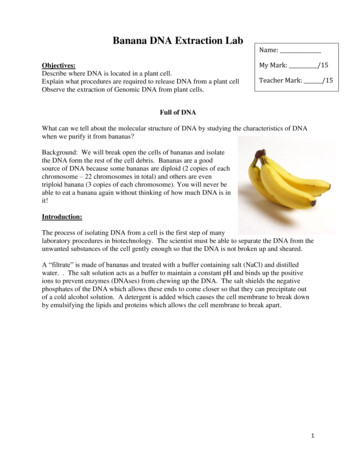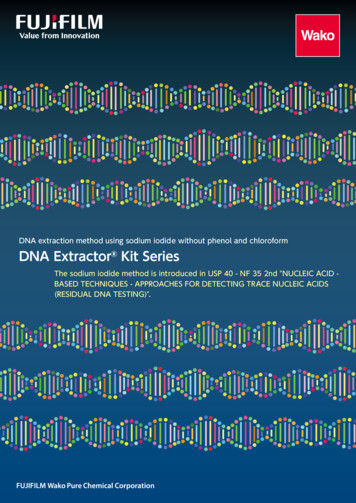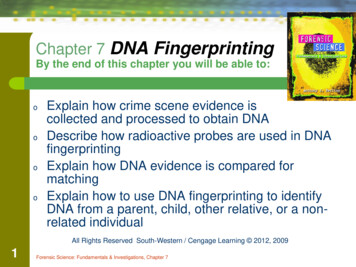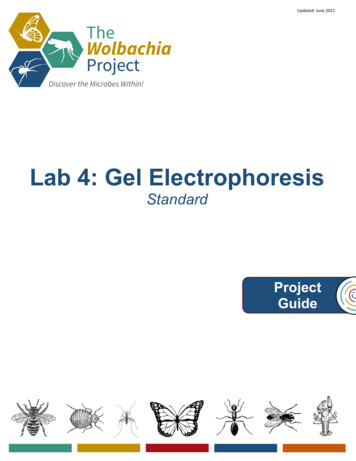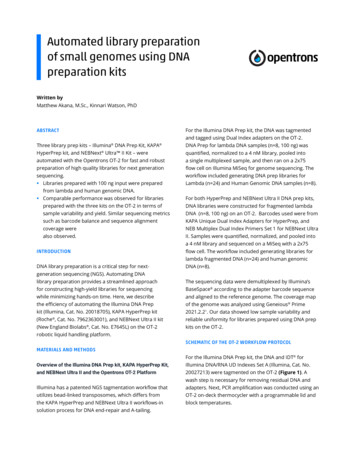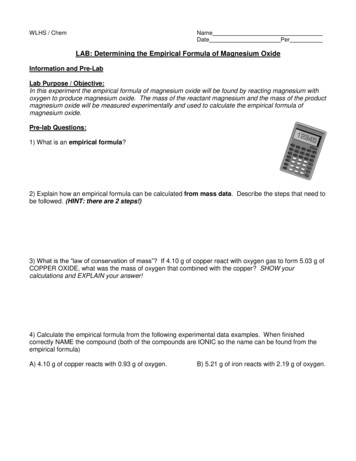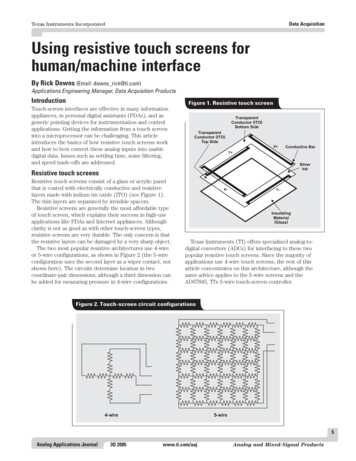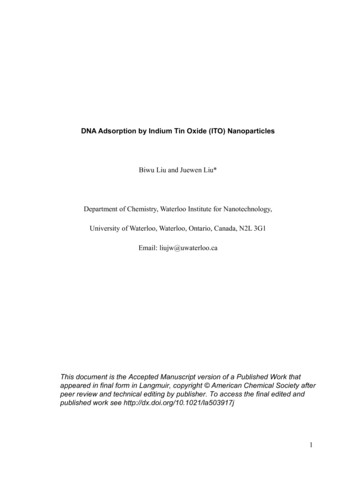
Transcription
DNA Adsorption by Indium Tin Oxide (ITO) NanoparticlesBiwu Liu and Juewen Liu*Department of Chemistry, Waterloo Institute for Nanotechnology,University of Waterloo, Waterloo, Ontario, Canada, N2L 3G1Email: liujw@uwaterloo.caThis document is the Accepted Manuscript version of a Published Work thatappeared in final form in Langmuir, copyright American Chemical Society afterpeer review and technical editing by publisher. To access the final edited andpublished work see http://dx.doi.org/10.1021/la503917j1
AbstractIndium tin oxide (ITO) is a highly important material since it is both conductive andtransparent. As a result, ITO is widely used in the electronic industry and recently itsapplication in biosensor development is also explored. We herein investigate its interactionwith DNA by studying the adsorption of fluorescently labeled and single-strandedoligonucleotides onto ITO nanoparticles. The fluorescence of DNA is efficiently quenchedafter adsorption and the interaction between DNA and ITO NPs is dependent on the surfacecharge of ITO, which is controlled by pH. Adsorption is greatly enhanced at low pH.Adsorption is also influenced by the sequence and length of DNA. For its components, In2O3adsorbs DNA more strongly while SnO2 repels DNA at neutral pH. The DNA adsorptionproperty is an averaging result from both components. DNA adsorption is confirmed to bemainly by the phosphate backbone via displacement experiments using free phosphate orDNA bases. Lastly, DNA induced DNA desorption by forming duplex DNA is demonstratedon ITO, while the same reaction is more difficult to achieve on other metal oxides includingCeO2, TiO2 and Fe3O4.2
IntroductionDNA-functionalized nanomaterials have attracted extensive research interests. These hybridmaterials combine the molecular recognition and programmable property of DNA with thephysical properties of inorganic nanoparticles, showing promising applications in many fieldsincluding biosensing,1-5 drug delivery,6 materials science,7-8 and nanotechnology.9-12 Over thepast two decades, many nanomaterials, such as metallic nanoparticles,13 semiconductorquantum dots,14 and nanoscale carbon materials (e.g. carbon nanotubes and grapheneoxide),15 have been modified with DNA. Each type of material has its own interaction forcefor DNA adsorption.A key step in constructing such materials is the attachment of DNA to the particle surface.Depending on the surface chemistry, several conjugation methods have been developed,including covalent bonding, metal coordination, and physisorption.16 While covalentattachment provides a strong linkage with DNA, physisorption is attractive due to itssimplicity, cost-effectiveness and reversible binding. For examples, DNA is readily adsorbedonto the graphene oxide surface via π-π stacking, and the complementary DNA (cDNA)induces DNA desorption by forming a duplex.15, 17 For gold nanoparticles (AuNPs), whilethiolated DNA is the main reagent for attachment, non-thiolated DNA has recently emergedas an alternative.18-19Metal oxides encompass a large number of important materials. In the last few years, theadsorption of DNA onto several metal oxides has been investigated.20-25 For example, by3
forming a DNA layer, the catalytic property of CeO2 was altered.21 Fluorescently labeledDNA molecules were used to detect arsenate ions in water based on the competitiveadsorption onto iron oxide nanoparticles.22Indium-doped tin oxide (ITO) is a very important material because it is both transparentand conductive.26 ITO electrodes are used in electrical27 and photolectrochemical28 biosensorsfor DNA as well as other targets. For example, Gao et al developed a photoelectrochemicalDNA sensor by conjugating an aldehyde-modified capture DNA onto a silanized ITOelectrode.29 The cDNA hybridization was followed by tagging a photoactive intercalator andthe increased photocurrent. In other applications, direct DNA-ITO interaction was utilized forthe detection of cDNA,30 DNA methylation,31 and pathogen.32 At the same time, nanoscaleITO particles are particular interesting in making electrodes.33-34 Some DNA-ITOnanoparticle (NP) conjugates have been made into conductive networks for DNA detection.35In spite of these analytical applications, little is known about the fundamentalinteractions between DNA and ITO. In this work, we study the adsorption of DNA oligomerson ITO NPs as a function of pH, salt concentration, and DNA sequence. By changing theoxide composition and displacement experiments, we also proposed the adsorptionmechanism. Finally, ITO was used to achieve DNA induced DNA desorption, which wasfound to be more difficult with other types of metal oxides.4
Material and MethodsChemicals.All of the DNA samples were purchased from Eurofins Scientific (Huntsville AL). Theirsequences and modifications are shown in Table 1. The indium oxide NPs (In2O3, 20-70 nm,stock number US3250), tin dioxide NPs (SnO2, 18 nm, stock number US3470) and indium tinoxide NPs (In2O3: SnO2 90: 10, 20-70 nm, stock number US3855) were purchased from USResearch Nanomaterials, Inc. (Houston, TX). Other metal oxides were from Sigma-Aldrich.Sodium acetate, sodium citrate, sodium phosphate, sodium chloride, 4-(2-hydroxyethyl)piperazine-1-ethanesulfonic acid (HEPES), 2-(N-morpholino) ethanesulfonic acid (MES) andnuclesosides were from Mandel Scientific (Guelph, ON, Canada). Milli-Q water was used forall of the experiments.Table 1. The sequences of DNA used in this workDNA namesSequences (from 5 to 3 ) and modificationsAlexa-DNA1TCA CAG ATG CGT-Alexa Fluoro 488FAM-DNA2FAM-ACG CAT CTG TGA AGA GAA CCT GGGsDNAACG CAT CTG TGA AGA GAA CCT GGGcDNACCC AGG TTC TCT TCA CAG ATG CGTFAM-A5FAM-AAA AAFAM-A15FAM-AAA AAA AAA AAA AAAFAM-T15FAM-TTT TTT TTT TTT TTTFAM-C15FAM-GGG GGG GGG GGG GGGFAM-G15FAM-CCC CCC CCC CCC CCCFAM-A30FAM-AAA AAA AAA AAA AAA AAA AAA AAA AAA AAA5
Dynamic light scattering (DLS)The ζ-potential of oxide dispersions was measured by DLS using Malvern Nanosizer ZS90.To measure the ζ-potential at different pH, the oxides were dispersed in designed pH buffers(10 mM, acetate buffer for pH 4 and 5, MES for pH 6, and HEPES for pH 7 and 8). The finalconcentration of ITO NPs is 50 µg/mL for most experiments unless otherwise specified.DNA adsorption and desorption kineticsTo study the effect of pH on adsorption kinetics, Alexa-DNA1 (10 nM) was dissolved intobuffers at different pH (10 mM). The initial fluorescence (F0) was monitored for 3 min(excitation at 485 nm, emission at 535 nm) using a microplate reader (Infinite F200Pro,Tecan). After a quick addition of ITO NP dispersion, the fluorescence was monitored foranother 20 min. The time-dependent studies of DNA adsorption at various NaClconcentrations or onto different oxides were performed in a similar way. To study desorptionof DNA from ITO NP surface, the DNA-ITO conjugates were prepared as described above atdesigned conditions. To test the effect of pH on DNA desorption, for example, the DNA-ITOconjugates were prepared by incubating Alexa-DNA1 (300 nM) with ITO NPs (500 µg/mL)at pH 4 for 1 h. After diluting the conjugated with Mill-Q water 10 times and monitoring thebackground fluorescence for 3 min, the pH was adjusted by adding 20 mM pH 7 or pH 8HEPES buffer. The fluorescence was monitored for another 30 min. To test the effects ofionic strength on desorption at pH 4, the conjugates were prepared in the same way and theionic strength was adjusted by adding various volumes of 5 M NaCl. To study displacement,the final concentrations of nucleosides and anions were 1 mM.6
DNA loading capacityThe DNA loading capacity was measured based on the fluorescence decrease upon addingITO or other oxides under various designed conditions. To test the effect of NaCl on DNAloading capacity at pH 7.6, for example, FAM-DNA2 (30 nM) was incubated with ITO (50μg/mL) at varying concentrations of NaCl. After 2 h incubation, the fluorescence wasmeasured to calculate adsorbed DNA.DNA induced desorptionTo study cDNA induced DNA desorption, FAM-DNA2 (10 nM) was incubated with ITO NPs(60 μg/mL) for 2 h and then dispersed in buffer solution (HEPES 10 mM, pH 7.6). Afteradding cDNA and 1 h reaction, the fluorescence was recorded. For the selectivity study, sameamount of cDNA and the same DNA (10 nM) was added. To compare different oxides, theDNA-oxides conjugates were prepared in the same buffer condition. The concentration ofprobe DNA (FAM-DNA2) and cDNA were both 10 nM. The concentrations of oxides are asfollows: [TiO2] 10 μg/mL, [Fe3O4] 12 μg/mL, [CeO2] 1 μg/mL, and [In2O3] 50μg/mL.7
Results and DiscussionEffect of surface charge. To have a complete understanding, in addition to ITO, we alsostudied In2O3 and SnO2, which are the basic ingredient of ITO. Instead of studying bulkplanar surfaces, we chose to use their NPs to achieve a large surface area and high adsorptioncapacity. In addition, NP interaction with DNA can be conveniently followed by opticalspectroscopy in the solution phase. These three oxides are crystalline as indicated by XRD(Figure S1). From TEM (Figure S2), the diameter of ITO NPs is ca. 50 nm. All these NPsappear aggregated, which is also reflected from their hydrodynamic sizes (e.g. 200 nm) bydynamic light scattering (DLS, Figure S3). Aggregation is attributed to the lack of strongcapping ligands and weak surface charge (vide infra). We are interested in studying DNAinteraction with the native oxide surface, and intentionally avoided adding strong ligands.Since DNA is highly negatively charged, the surface charge of the oxides is likely to beimportant for determining the interaction force. We next measured the ζ-potential of the NPsas a function of pH (Figure 1A). All the three NPs are positively charged at low pH andnegatively charged at high pH. The point of zero charge (PZC) is however different for eachone. The ITO NPs are negatively charged when pH is higher than 7 and its PZC is betweenpH 6 and 7. Interestingly, the PZC of SnO2 is close to 4 and In2O3 is between 7 and 8. Thissuggests that the surface charge of ITO might be controlled by either tuning pH or bychanging the Sn/In ratio. Most oxides are capped by hydroxide groups in water, and theirsurface charge normally comes from the (de)protonation of these –OH groups.After understanding surface charge, we tested the effect of pH for DNA adsorption. We8
employed an Alexa Fluoro 488 (AF) labeled 12-mer DNA (Alexa-DNA1) and thisfluorophore is insensitive to pH change. At pH 4, all the three NPs quenched the fluorescence(Figure 1B). This indicates two important facts. First, DNA can be adsorbed by all these NPsat pH 4. Second, these NPs can quench adsorbed fluorophores, which provides a convenientmethod for subsequent studies. This is consistent with that all the NPs are positively chargedat pH 4. At pH 7, almost no quenching was observed for SnO2, and ITO showed moderatequenching. Full quenching was achieved only with In2O3. This trend also agrees with thesurface charging of the NPs at pH 7. This simple experiment established that AF-labeledDNA is a useful probe for studying DNA adsorption.Figure 1. (A) The effect of pH on the ζ-potential of ITO, In2O3 and SnO2 NPs. (B)Photographs showing fluorescence quenching of Alexa-DNA1 (100 nM) by the three oxideNPs (500 µg/mL) at pH 7 and pH 4. The blank groups are the free DNA without any oxides.The photographs were taken under a Safe Imager 2.0 Blue-Light Transilluminator by adigital camera.For a quantitatively study, we measured the kinetics of DNA adsorption (Figure 2A). AtpH 8, almost no DNA was adsorbed onto ITO NPs as indicated by stable fluorescence signals.9
However, a dramatic fluorescence decrease was observed at pH 6 attributable to the changeof surface charge of ITO NPs from negative to positive. The rate of adsorption is quite fast,approaching equilibrium in 1 min at pH 6, while slower adsorption occurred at pH 7. Theeffect of pH was also studied by measuring the DNA loading capacity at various pH’s (Figure2B). Using a higher concentration of DNA and after 2 h incubation, over 95% DNAadsorption was achieved at low pH, while less than 5% DNA was adsorbed at pH 8.Next we studied the reversibility of DNA adsorption. When the pH of the preparedDNA-ITO conjugates was adjusted back to neutral or basic, a fast fluorescence increase wasobserved (Figure 2C), suggesting DNA desorption. Combined with the ζ-potentialmeasurement in Figure 1A, we conclude that electrostatic interaction plays a critical role inDNA adsorption.Figure 2. Effect of pH on the (A) adsorption kinetics, (B) loading capacity, and (C)desorption kinetics of Alexa-DNA1 by ITO. The buffer concentration is 10 mM in theabsence of additional salt.Effect of ionic strength. Since most DNA assays are performed at neutral or physiological10
pH, next we studied DNA adsorption at pH 7.6. At this pH, both DNA and ITO NPs arenegatively charged, and adding salt might be useful for screening charge repulsion. Figure 3Ashows the adsorption kinetics as a function of NaCl concentration. In the absence of NaCl,there is a fast initial fluorescence drop followed by a slow decrease. The addition of NaClindeed increased the adsorption rate. However, salt concentration did not appear to veryimportant, where similar adsorption was achieved with 30 mM and 300 mM NaCl. The effectof NaCl on DNA loading capacity is also similar (Figure 3C). With over 30 mM salt, thecapacity reached saturation. This study suggests that the electrostatic repulsion is quite weakbetween DNA and ITO at pH 7.6 and it can be effectively screened with just 30 mM NaCl.From the DNA loading capacity data, we reason that the electrostatic repulsion amongDNA is also weak on ITO. For example, adsorption of thiolated DNA by AuNPs is stronglyinfluenced by NaCl concentration and the highest adsorption capacity was achieved at 700mM NaCl.36 Such high salt is mainly used to screen the repulsion among the dense DNAlayer that are in an upright conformation. For ITO, the DNA capacity at neutral pH is muchlower (vide infra) and salt only needs to screen the DNA/ITO repulsion.Next, we compared the adsorption kinetics of FAM-labeled DNA2 by the three NPs(Figure 3B). As expected, In2O3 is the most effective in DNA adsorption, while SnO2 is theslowest, leaving ITO in between. This again agrees with the surface charging property. SnO2is highly negatively charged at pH 7.6 and the added NaCl was insufficient to screen therepulsion.To further understand the mechanism of adsorption, the adsorption isotherm by ITO was11
measured (Figure 3D). It exhibits a typical Langmuir type of adsorption behavior, indicatingmonolayer and reversible adsorption. The highest DNA loading coverage is ca. 12 nM for a24-mer DNA (FAM-DNA2) onto 50 µg/mL ITO NPs. Assume the NPs are 50 nm in diameterand 50 µg/mL of ITO NPs is ca. 0.178 nM. Therefore each ITO NP adsorbs 68 molecules of24-mer DNA. Compared thiolated DNA onto 50 nm AuNPs (640 80 DNAs per particles),37this coverage is much lower. This suggests that the DNA wraps around ITO instead ofadopting an upright conformation as in the case of AuNPs.Figure 3. Adsorption kinetics (A) and loading capacity (C) of FAM-DNA2 on ITO NPs as afunction of NaCl concentration (10 mM HEPES, pH 7.6). (B) The DNA adsorption kineticsonto various oxides. (D) DNA adsorption isotherm by ITO NPs with 150 mM NaCl at pH 7.6.NP concentration 50 µg/mL.12
Effect of DNA length and sequence. One advantage of DNA-based assays is that the lengthand sequence of DNA can be readily controlled, which may provide further mechanisticinsights. The loading of FAM labeled homo 15-mer DNA at pH 7.6 (NaCl 150 mM) and atpH 4 was performed (Figure 4). The loading capacities of all DNA at pH 4.0 are 50-100 foldsof those at pH 7.6, highlighting the importance of surface charge of the oxides. Since poly-Aand poly-C DNA can be partially protonated at pH 4, they showed higher capacity than thepoly-G and poly-T DNA.Next, we studied the effect of DNA length (Figure 4B). At pH 4, the A15 DNA adsorbedthe most. Although its loading is only 20% more than that for A5, its number of adeninenucleotide is 300% more. We reason that the 5-mer DNA is too short and it has very weakaffinity. On the other hand, the 30-mer DNA is too long and it occupies more footprints onthe particle surface. The capacity of the 30-mer DNA is roughly 50% of the 15-mer andtherefore, they adsorb a similar number of nucleotides. At pH 7.6, all the DNAs wereadsorbed with a very low capacity, and this is again attributed to the strong charge repulsionwith the ITO surface.Figure 4. The effect of DNA sequence (A) and length (B) on loading capacity onto ITO NPs13
at pH 4.0 and 7.6. The initial concentration of DNA added at pH 7.6 and 4.0 are 30 nM and200 nM, respectively.Adsorption mechanism. A DNA has two main components that could be responsible foradsorption: phosphate and the nucleobases. To understand the adsorption mechanism, a seriesof displacement experiments were carried out. The DNA-ITO conjugates were exposed tonucleosides and several anions. No significant DNA desorption was observed in the presenceof the nucleosides at pH 7.6, suggesting the lack of strong interaction between the bases andITO (Figure 5A). We also tested the effect of various common anions (Figure 5B). Citrate andphosphate displaced adsorbed DNA quickly while the other anions had no effect. Therefore, itis likely that the phosphate on DNA backbone is responsible for DNA adsorption. Afteradding phosphate, the ζ-potential of ITO NPs is also decreased (although still positive, Figure5C), suggesting that phosphate partially caps the particle surface. Taken together, thephosphate backbone of DNA electrostatically adsorb onto ITO.Figure 5. Displacement assays of DNA-ITO conjugates by (A) 1 mM nucleosides and (B) 1mM various anions. Only citrate and phosphate induced desorption. (C) ζ-potential of ITONPs at pH 4 in the presence of various buffer anions (100 µM).14
DNA induced desorption. After understanding DNA adsorption, we next studied cDNAinduced desorption. The FAM-labeled probe DNA was first adsorbed onto ITO. Addition ofcDNA induced a concentration-dependent fluorescence recovery (Figure 6A). As low as 0.7nM cDNA can be detected based on signal greater than 3 times of background variation(inset). This performance is comparable to that reported with GO for a similar detectionscheme.15, 38 It is interesting to note that at high cDNA concentration (e.g. 60 nM), thereleased FAM-DNA was only 66% of the adsorbed. The remaining probe were still adsorbed.This suggests that the surface of ITO might be heterogeneous and the places with moreindium component might adsorb DNA more stably and cannot be released by the cDNA.To test the specificity of this cDNA induced probe release, we also added a DNA with thesame sequence as the probe DNA but non-labeled (named sDNA, Figure 6B). In this case, thereleased probe DNA was negligible, suggesting that formation of duplex is a driving force forDNA desorption. Since duplex DNA still maintains negatively charged property, it suggeststhat rigid duplex binding to ITO surface is less favorable compared to the flexiblesingle-stranded DNA.To compare ITO with other metal oxides, we adsorbed FAM-labeled DNA onto TiO2,Fe3O4, CeO2, and In2O3. SnO2 was not included since it does not adsorb DNA at pH 7.6. ThencDNA was added and only ITO resulted in a large fraction of DNA release (Figure 6C).Therefore, ITO is a unique metal oxide for DNA-induced DNA desorption (Figure 6D). Thisis attributed to the weak electrostatic interaction between DNA and ITO NPs. It is interestingto note that In2O3 exhibits a low response in the presence of cDNA, which might be related to15
its positive surface charge and can further adsorption the cDNA. It is like that SnO2 has amodulation effect to weaken adsorption capability. Our ITO NPs contain 10% SnO2 and 90%In2O3, meaning that a small doping can significantly adjust the adsorption affinity.Figure 6. Sensing performance of FAM-DNA2 functionalized ITO. (A) Fluorescenceresponse as a function of cDNA concentration after 1 h reaction. (B) Selectivity test in thepresence of 10 nM of cDNA and sDNA. (C) Comparison of several DNA-oxide conjugates incDNA detection. The probe DNA and cDNA concentration are 10 nM in all the samples. (D)A scheme of DNA desorption in the presence of cDNA from ITO. For other oxides, thecDNA induced DNA desorption is less efficient and likely the added cDNA is also adsorbeddue to their stronger affinity for DNA.16
ConclusionsIn summary, a systematic study was carried out to understand DNA adsorption by ITO. Weshow that fluorescently labeled single-strand of DNA can be adsorbed by ITO NPs, inducingfluorescence quenching. The surface charge of ITO is important in maximizing the DNAloading. From displacement experiments, DNA adsorption is mainly through the phosphatebackbone via electrostatic interaction with the ITO surface. The ITO-DNA conjugate can beused to detect cDNA down to 0.7 nM. Interestingly, ITO shows an averaged behavior of SnO2and In2O3. Doping the tin component has weakened DNA binding affinity, making it possibleto directly detect cDNA. For comparison, most other oxides adsorb DNA too tightly and theadsorbed DNA cannot be easily desorbed in the presence of cDNA. This study providedfundamental insights into DNA interaction with ITO, which is an important transparentelectrode material useful for biosensor development.AcknowledgmentFunding for this work is from the University of Waterloo, the Canadian Foundation forInnovation, and the Natural Sciences and Engineering Research Council (NSERC) of Canada,and the Early Researcher Award from the Ontario Ministry of Research and Innovation.Supporting Information available. TEM, XRD, DLS of metal oxides. This material isavailable free of charge via the Internet at http://pubs.acs.org.17
References(1) Rosi, N. L.; Mirkin, C. A. Nanostructures in Biodiagnostics. Chem. Rev. 2005, 105,1547-1562.(2) Wang, H.; Yang, R. H.; Yang, L.; Tan, W. H. Nucleic Acid Conjugated Nanomaterials forEnhanced Molecular Recognition. ACS Nano 2009, 3, 2451-2460.(3) Liu, J.; Cao, Z.; Lu, Y. Functional Nucleic Acid Sensors. Chem. Rev. 2009, 109,1948-1998.(4) Song, S. P.; Qin, Y.; He, Y.; Huang, Q.; Fan, C. H.; Chen, H. Y. Functional Nanoprobes forUltrasensitive Detection of Biomolecules. Chem. Soc. Rev. 2010, 39, 4234-4243.(5) Zhao, W.; Brook, M. A.; Li, Y. Design of Gold Nanoparticle-Based ColorimetricBiosensing Assays. ChemBioChem 2008, 9, 2363-2371.(6) Giljohann, D. A.; Seferos, D. S.; Daniel, W. L.; Massich, M. D.; Patel, P. C.; Mirkin, C. A.Gold Nanoparticles for Biology and Medicine. Angew. Chem. Int. Ed. 2010, 49, 3280-3294.(7) Park, S. Y.; Lytton-Jean, A. K. R.; Lee, B.; Weigand, S.; Schatz, G. C.; Mirkin, C. A.DNA-programmable Nanoparticle Crystallization. Nature 2008, 451, 553-556.(8) Nykypanchuk, D.; Maye, M. M.; van der Lelie, D.; Gang, O. DNA-guided Crystallizationof Colloidal Nanoparticles. Nature 2008, 451, 549-552.(9) Katz, E.; Willner, I. Integrated Nanoparticle-Biomolecule Hybrid Systems: Synthesis,Properties, and Applications. Angew. Chem. Int. Ed. 2004, 43, 6042-6108.(10) Cheng, W. L.; Campolongo, M. J.; Cha, J. J.; Tan, S. J.; Umbach, C. C.; Muller, D. A.;Luo, D. Free-standing Nanoparticle Superlattice Sheets Controlled by DNA. Nat. Mater. 2009,18
8, 519-525.(11) Pinheiro, A. V.; Han, D.; Shih, W. M.; Yan, H. Challenges and Opportunities forStructural DNA Nanotechnology. Nat. Nanotechnol. 2011, 6, 763-772.(12) Lu, Y.; Liu, J. Smart Nanomaterials Inspired by Biology: Dynamic Assembly ofError-Free Nanomaterials in Response to Multiple Chemical and Biological Stimuli. Acc.Chem. Res. 2007, 40, 315-323.(13) Mirkin, C. A.; Letsinger, R. L.; Mucic, R. C.; Storhoff, J. J. A DNA-based Method forRationally Assembling Nanoparticles into Macroscopic Materials. Nature 1996, 382,607-609.(14) Mitchell, G. P.; Mirkin, C. A.; Letsinger, R. L. Programmed Assembly of DNAFunctionalized Quantum Dots. J. Am. Chem. Soc. 1999, 121, 8122-8123.(15) Lu, C.-H.; Yang, H.-H.; Zhu, C.-L.; Chen, X.; Chen, G.-N. A Graphene Platform forSensing Biomolecules. Angew. Chem. Int. Ed. 2009, 48, 4785-4787.(16) Sapsford, K. E.; Algar, W. R.; Berti, L.; Gemmill, K. B.; Casey, B. J.; Oh, E.; Stewart, M.H.; Medintz, I. L. Functionalizing Nanoparticles with Biological Molecules: DevelopingChemistries that Facilitate Nanotechnology. Chem. Rev. 2013, 113, 1904-2074.(17) Liu, B.; Sun, Z.; Zhang, X.; Liu, J. Mechanisms of DNA Sensing on Graphene Oxide.Anal. Chem. 2013, 85, 7987-7993.(18) Pei, H.; Li, F.; Wan, Y.; Wei, M.; Liu, H.; Su, Y.; Chen, N.; Huang, Q.; Fan, C. DesignedDiblock Oligonucleotide for the Synthesis of Spatially Isolated and Highly HybridizableFunctionalization of DNA-Gold Nanoparticle Nanoconjugates. J. Am. Chem. Soc. 2012, 134,19
11876-11879.(19) Zhang, X.; Liu, B.; Dave, N.; Servos, M. R.; Liu, J. Instantaneous Attachment of anUltrahigh Density of Nonthiolated DNA to Gold Nanoparticles and Its Applications.Langmuir 2012, 28, 17053-17060.(20) Zhang, X.; Wang, F.; Liu, B.; Kelly, E. Y.; Servos, M. R.; Liu, J. Adsorption of DNAOligonucleotides by Titanium Dioxide Nanoparticles. Langmuir 2014, 30, 839-845.(21) Pautler, R.; Kelly, E. Y.; Huang, P.-J. J.; Cao, J.; Liu, B.; Liu, J. Attaching DNA toNanoceria: Regulating Oxidase Activity and Fluorescence Quenching. ACS Appl. Mater.Interfaces 2013, 5, 6820-6825.(22) Liu, B.; Liu, J. DNA Adsorption by Magnetic Iron Oxide Nanoparticles and itsApplication for Arsenate Detection. Chem. Commun. 2014, 50, 8568-8570.(23) Zuo, S.-H.; Zhang, L.-F.; Yuan, H.-H.; Lan, M.-B.; Lawrance, G. A.; Wei, G.Electrochemical Detection of DNA Hybridization by Using a Zirconia Modified RenewableCarbon Paste Electrode. Bioelectrochemistry 2009, 74, 223-226.(24) Fahrenkopf, N. M.; Rice, P. Z.; Bergkvist, M.; Deskins, N. A.; Cady, N. C.Immobilization Mechanisms of Deoxyribonucleic Acid (DNA) to Hafnium Dioxide (HfO2)Surfaces for Biosensing Applications. ACS Appl. Mater. Interfaces 2012, 4, 5360-5368.(25) He, D.; He, X.; Wang, K.; Yang, X.; Yang, X.; Li, X.; Zou, Z. Nanometer-sizedManganese Oxide-quenched Fluorescent Oligonucleotides: an Effective Sensing Platform forProbing Biomolecular Interactions. Chem. Commun. 2014, 50, 11049-11052.(26) Liu, H.; Avrutin, V.; Izyumskaya, N.; Özgür, Ü.; Morkoç, H. Transparent Conducting20
Oxides for Electrode Applications in Light Emitting and Absorbing Devices. SuperlatticesMicrostruct. 2010, 48, 458-484.(27) Paleček, E.; Bartošík, M. Electrochemistry of Nucleic Acids. Chem. Rev. 2012, 112,3427-3481.(28) Zhao, W.-W.; Xu, J.-J.; Chen, H.-Y. Photoelectrochemical DNA Biosensors. Chem. Rev.2014, 114, 7421-7441.(29) Gao, Z.; Tansil, N. C. An Ultrasensitive Photoelectrochemical Nucleic Acid Biosensor.Nucleic Acids Res. 2005, 33, e123.(30) Armistead, P. M.; Thorp, H. H. Modification of Indium Tin Oxide Electrodes withNucleic Acids: Detection of Attomole Quantities of Immobilized DNA by Electrocatalysis.Anal. Chem. 2000, 72, 3764-3770.(31) Wei, X.; Ma, X.; Sun, J.-j.; Lin, Z.; Guo, L.; Qiu, B.; Chen, G. DNA MethylationDetection and Inhibitor Screening Based on the Discrimination of the Aggregation of Longand Short DNA on a Negatively Charged Indium Tin Oxide Microelectrode. Anal. Chem.2014, 86, 3563-3567.(32) Patel, M. K.; Singh, J.; Singh, M. K.; Agrawal, V. V.; Ansari, S. G.; Malhotra, B. D. TinOxide Quantum Dot Based DNA Sensor for Pathogen Detection. J. Nanosci. Nanotechnol.2013, 13, 1671-1678.(33) Lee, J.; Lee, S.; Li, G.; Petruska, M. A.; Paine, D. C.; Sun, S. A Facile Solution-PhaseApproach to Transparent and Conducting ITO Nanocrystal Assemblies. J. Am. Chem. Soc.2012, 134, 13410-13414.21
(34) Yun, J.; Park, Y. H.; Bae, T.-S.; Lee, S.; Lee, G.-H. Fabrication of a CompletelyTransparent and Highly Flexible ITO Nanoparticle Electrode at Room Temperature. ACSAppl. Mater. Interfaces 2012, 5, 164-172.(35) Fan, Y.; Chen, X.; Kong, J.; Tung, C.-h.; Gao, Z. Direct Detection of Nucleic Acids byTagging Phosphates on Their Backbones with Conductive Nanoparticles. Angew. Chem. Int.Ed. 2007, 46, 2051-2054.(36) Hurst, S. J.; Lytton-Jean, A. K. R.; Mirkin, C. A. Maximizing DNA Loading on a Rangeof Gold Nanoparticle Sizes. Anal. Chem. 2006, 78, 8313-8318.(37) Hill, H. D.; Millstone, J. E.; Banholzer, M. J.; Mirkin, C. A. The Role Radius ofCurvature Plays in Thiolated Oligonucleotide Loading on Gold Nanoparticles. ACS Nano2009, 3, 418-424.(38) He, S.; Song, B.; Li, D.; Zhu, C.; Qi, W.; Wen, Y.; Wang, L.; Song, S.; Fang, H.; Fan, C.A Graphene Nanoprobe for Rapid, Sensitive, and Multicolor Fluorescent DNA Analysis. Adv.Funct. Mater. 2010, 20, 453-459.22
For TOC graphics only23
including covalent bonding, metal coordination, and 16physisorption. . (Houston, TX). Other metal oxides were from Sigma-Aldrich. Sodium acetate, sodium citrate, sodium phosphate, sodium chloride, 4-(2-hydroxyethyl) . FAM-AAA AA FAM-A 15 FAM-AAA AAA AAA AAA AAA FAM-T 15 FAM-TTT TTT TTT TTT TTT FAM-C 15 FAM-GGG GGG GGG GGG GGG FAM-G 15
